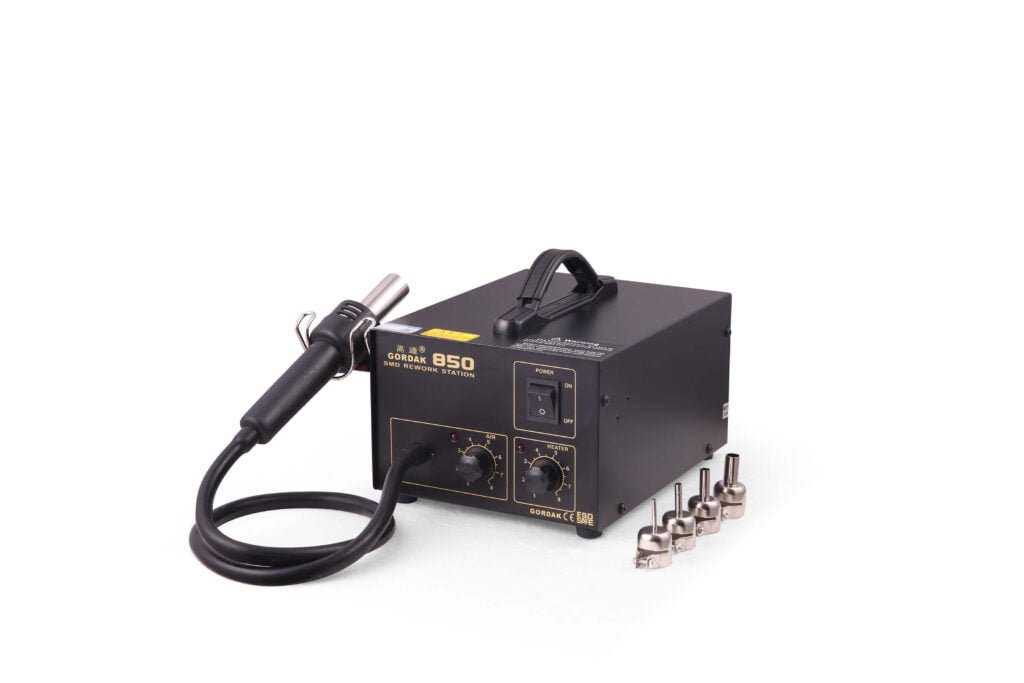拆焊表面安装器件 (SMD) 是电子产品维修、返工和原型制作中的一项关键工序。随着越来越多地使用结构紧凑、密度高的印刷电路板,拥有正确的工具和技术至关重要。在这项工作中,最有效的非侵入式工具之一是 热风返修站.
At Gordak Electric, we specialize in developing reliable, easy-to-use hot air rework stations that support technicians and engineers in achieving safe and efficient desoldering results. In this guide, we explain how to properly desolder SMD components using a hot air rework station.
为什么使用热风返修站进行 SMD 脱焊?
SMD 元件直接焊接在 PCB 表面,通常有多个细间距引线或焊盘。传统烙铁难以胜任如此精密的工作。热风返修站:
- 提供 无接触加热减少机械损坏的风险
- 允许 均匀加热特别是在多针元件上
- 适用于 多种 SMD 封装包括 SOIC、QFP 和 BGA

您需要的工具
- 热风返修站 (如 Gordak 850、Gordak 857、Gordak 958 系列)。
- 防静电镊子或真空拾取工具
- 助焊剂(可选,但建议使用)
- 放大镜(小部件可选)
- 焊芯或焊吸 (用于清洗残余焊料)
- 防静电垫和腕带 (用于静电保护)

SMD 元件拆焊分步指南
1. 打开返修站电源并设置参数
- Temperature: Set to around 280°C to 350°C, depending on the solder type and board sensitivity
- Airflow: Use low to medium airflow to avoid displacing nearby components
- 等待热风枪达到设定温度后再继续操作
2. 准备工作区
Ensure your PCB is clean, dry, and secured on an anti-static surface. Apply a small amount of flux around the component to help the solder melt evenly and reduce oxidation.
3. 选择正确的喷嘴
选择适合部件尺寸的喷嘴。较小的喷嘴可以更好地控制气流和加热焦点。
4. 均匀加热
Hold the hot air gun about 2–4 cm above the component. Move the nozzle in gentle circular or side-to-side motions to distribute heat evenly across all solder joints. Avoid holding the nozzle still to prevent overheating the board.
仔细观察--当焊料融化时,元件将变得自由。
5. 提升组件
Once the solder is molten, carefully lift the component using anti-static tweezers or a vacuum pickup tool. Do not force it—if there’s resistance, continue applying heat for a few more seconds.
6. 清洁护垫
After removal, clean the remaining solder from the pads using solder wick or a solder sucker, followed by gentle wiping with isopropyl alcohol. This ensures a clean surface for future reinstallation or inspection.
7. 冷却和断电
拆焊后,将热风枪放回枪架。让热风运行一小会儿,以冷却加热元件(特别是带有智能冷却功能的 Gordak 型号),然后安全关闭工作站。
安全提示
- Always wear eye protection when working with hot solder
- Use ESD-safe tools and environment to protect sensitive components
- 避免电路板过热,以防焊盘翘起或分层
- 在处理贵重电子设备之前,先在废电路板上进行练习
为什么选择 Gordak Electric?
Gordak Electric 是热风返修站和焊接解决方案的领先制造商。我们的设备在全球范围内深受信赖:
- 稳定精确的温度控制
- 耐用、高效设计
- 方便用户的界面 适合初学者和专业人士
- 支持 OEM 和 ODM 面向全球客户
如需进一步了解我们的产品系列或索取报价,请联系我们:
电子邮件: info@gordakelec.com



